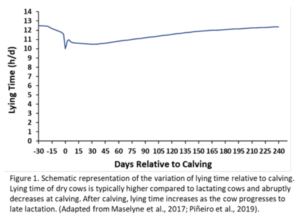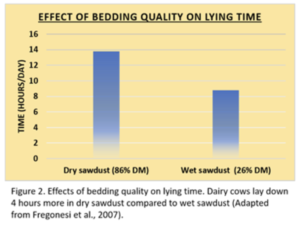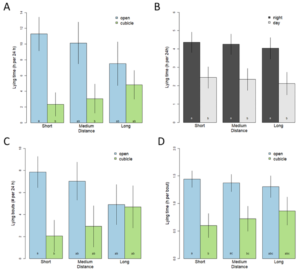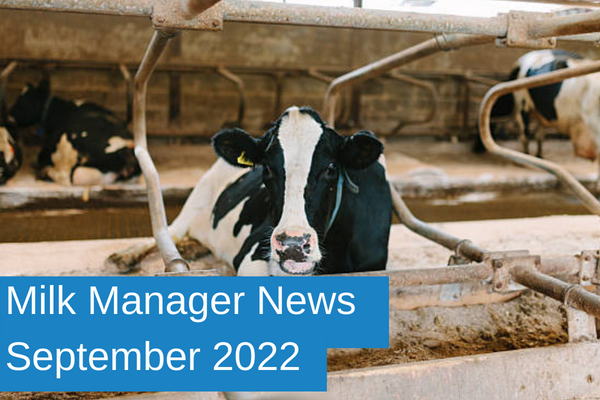Milk Manager News September 2022 – The Importance of an Open Area for Lying Down in Dairy Cows
13 September 2022Lying down is a critically important behavioural need for dairy cattle, and as such it is an important metric to measure the comfort of cow accommodation. Insufficient lying time leads to increased stress, decreased feeding time and lameness. This in turn, decreases milk production, fertility and cow longevity. Lying time varies depending on where the cow is in the lactation cycle, but cows should typically spend around 12 hours a day lying down (see figure 1 below).
The good news is that lying time is dependent on our cow management practices and the housing environment that we provide, so we can control and improve it. Good management practices such as avoiding frequent regrouping and keeping heifers in a separate group to decrease competition between cows have been found to increase lying time in various studies. In addition, minimising time cows spend away from the lying area being milked, handled etc is also good practice.
The environment we provide for cattle also affects lying time. Poor ventilation and temperature control decreases lying time. The comfort of the lying areas is dependent on the size of cubicles or loafing area as well as the choice of bedding material, and also affects the cattle’s lying time and choice of lying area (see figure 2).
A recent study carried out at the Agri-EPI Midlands Dairy Research Centre at Harper Adams University in conjunction with researchers from SRUC’s Dairy Research Centre at Crichton measured cow motivation to access different lying down areas. Lying down areas and loafing areas provide a better space for cows to express oestrus behaviour and for lower-ranking cows to escape dominants.
Thirty Holstein-Friesian cows were housed in groups of five in an indoor robotic milking unit with easy access to six mattress-bedded cubicles. To assess the cattle’s motivation to access open lying areas, the cows had the option to walk further via a one-way indoor raceway to access the open lying areas. This was repeated at various distances; short (34.5m) Medium (80.5m) and Long (126.5m), to assess how the distance to the lying areas affected their choice of lying area. The study measured cow motivation to walk to open lying areas with both mattresses and straw bedded areas versus their willingness to just lay in the mattress bedded cubicles.
Overall, cows lay down for longer on the open lying areas at each distance compared to the cubicles, with cows lying down slightly longer on straw than on the matts, although lying times on the open lying areas did decrease at the longer distances (see figure 3). However, cows were still lying for >60% of their lying time on the open lying areas at the long distance. This study demonstrates that cows prefer open lying areas over cubicles and the provision of which could better cater for the behavioural needs of housed dairy cows and improve housed dairy cow welfare.
Figure 3. Lying as a function of distance choice treatment
References:
Shewbridge Carter, L, Haskell, MJ, Ball, D, Gibbons, J, Harris, WE & Rutter, SM. 2022, ‘Dairy cows value an open area for lying down’, PLoS ONE, vol. 17, no. 5, pp. e0268238. https://doi.org/10.1371/journal.pone.0268238
Spencer J A and Piñeiro J, ‘Lying Time of Dairy Cows: Importance of a behavioural need’ 29/05/2020 https://www.dairybusiness.com/lying-time-of-dairy-cows-importance-of-a-behavioral-need/
james.orr@sac.co.uk; 01292 525010
Sign up to the FAS newsletter
Receive updates on news, events and publications from Scotland’s Farm Advisory Service




